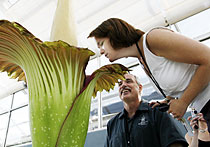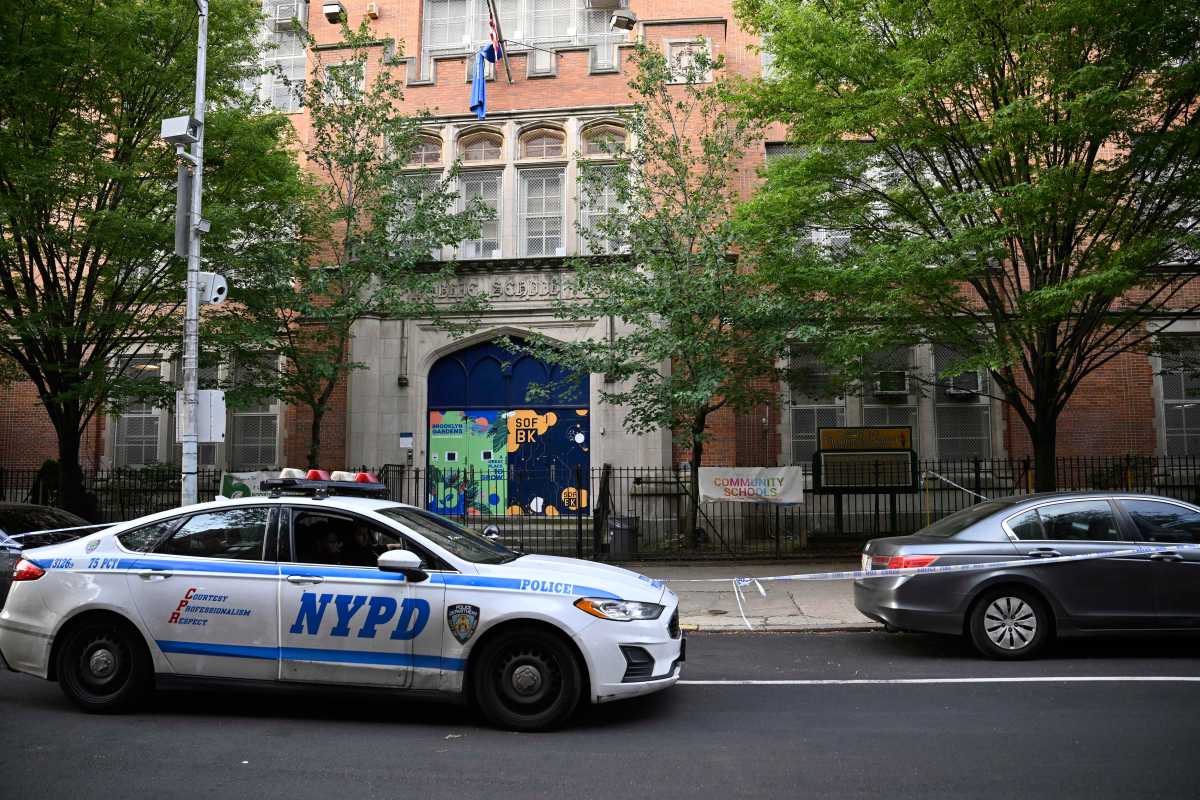Let’s talk about sex, Baby.
Or, more precisely, sex with Baby, the Brooklyn
Botanic Garden’s now-famous stinking corpse flower.
I was a witness to the racy proceedings on Aug. 11, along with
at least a dozen others, when Dr. Alessandro Chiari, plant propagator
at the garden, and Baby, the garden’s beloved Amorphophallus
titanum, shared an intimate moment designed to bear fruit.
Chiari lovingly caressed Baby’s female flowers – nestled inside
the base of her large outer petal, or spathe – with a camel hair
paintbrush in order to deposit moistened pollen from another
plant.
Although her name’s Baby, she’s really 10 years old, and as of
Friday morning, she had rotten, stinking halitosis. (While the
corpse flower emits the putrid perfume to entice pollinators
– like carrion beetles and sweat bees in the rainforests of Sumatra
– at BBG it only served to attract some flies and 33,000 human
visitors.)
While on Friday this regal flower – with the world’s most rancid
scent – sported a giant, fleshy "phallus," or spadix,
sprouting proudly from the center of its spathe, a look at the
garden’s Web cam just five days later revealed that the stinking
protrusion was quite flaccid, lolling over like a flat tongue.
Her outer petal – once a ruffle of green and veined foliage on
the outside, like celery, that had curled back to reveal a hue
akin to dried blood on the inside – was closed up tight like
an umbrella by Aug. 16.
But over the previous weekend, Baby had put on a show for the
crowds that encircled the giant flower in her enormous terra
cotta pot, straining their necks over the ropes for a whiff of
her peculiar aroma.
After being nurtured for 10 years by the garden, the plant finally
sprouted a flower on July 31, which ultimately grew to a height
of 66.5-inches and 40-inches wide, and did finally produce the
storied, horrendous stink early in the morning of Aug. 11.
Chiari said the smell seemed to be emanating in waves from a
fluid that the flower was "oozing" from its spadix
(which is an enormous version of the one at the center of the
corpse flower’s prim cousin – a star in many bridal bouquets
– the calla lily).
During the wee morning hours of Friday, the plant’s caretakers
reported that Baby’s stench was comparable to everything from
dead rats to a fishing dock at low tide.
But the odor had faded so much by Friday afternoon that Chiari,
who needed to wear a respirator to keep from vomiting into the
flower earlier in the day ("I didn’t want to be hit with
a wave while my head was in there," he confided. "I
was a little bit nauseous. Better safe than sorry."), was
able to pollinate the plant without so much as a nose plug.
Baby is Chiari’s first experience with a corpse flower, and he
was so excited he couldn’t sleep Thursday night, he told GO Brooklyn.
"I came back around 5 in the morning, because I wanted to
make sure everything was OK."
Baby’s blooming was such a special occasion that BBG’s Herbarium
Supervisor Paul Harwood "rushed in" from his vacation
for a day to come and sketch the plant, so her plumage could
be documented for posterity.
"It’s very unusual, amazing, wonderful," said Harwood
of his first opportunity to glimpse a corpse flower in the flesh.
The hope now for Baby’s caretakers is that the pollination was
successful, and in two to three weeks she will swell with the
fruit that will contain the seeds that the garden can use to
grow more of these rare, endangered, smelly corpse flowers.
The Brooklyn Botanic Garden is located at 900 Washington Ave.
at Eastern Parkway in Prospect Heights. Viewing is free with
garden admission ($5 adults, $3 seniors and students with ID,
free for children younger than 16). For more information about
Baby, visit the Web site, www.bbg.org.

























